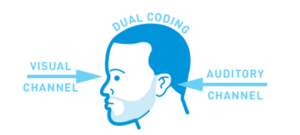The dual coding theory is a cognitive theory, proposed by Allan Paivio of the University of Western Ontario in 1971. In developing this theory, Paivio used the idea that the formation of mental images facilitates learning. (Thomas, 2020) For making power point, we could add some media, such as pictures or videos to help audience to understand the meaning.

Hypothes.is has useful benefits. For example, I have seen some students are using iPad during the in-class lecture that makes me to get an iPad. However, Hypothes.is can solve this problem. I can not only make notes on pdf, I can also make notes on the web, and share comments to other classmates or instructor. When I have questions, I can highlight the questions and ask the instructor. It makes students to skip sending e-mail part. It is convenient and the instructor will easily clarify the question and answer the question.

I believe multimedia learning is a great way to learn. In Eastern teaching style, the students receive what instructor says, thus you will not be able to see students discuss in class or communicate with each other in our class. And the instructor will less use multimedia for teaching. It makes lecture boring.
Reference:
Thomas, Nigel J.T., “Mental Imagery”, The Stanford Encyclopedia of Philosophy (Fall 2020 Edition), Edward N. Zalta (ed.), URL = <https://plato.stanford.edu/archives/fall2020/entries/mental-imagery/>.
